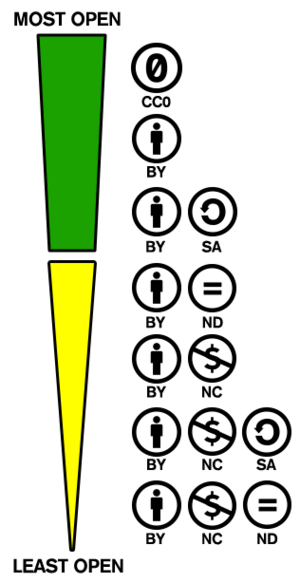
Creative Commons offers authors, artists, scientists, teachers and all other creative makers the freedom to handle their copyrights in a flexible way. With a choice of six (free) standard licenses available, the copyright holder determines to what extent his or her work may be further distributed, and under what conditions this may be done.
With a Creative Commons license you retain all your rights, but you give permission to others to distribute your work, to share with others or, with some licenses, to edit the work. Listing your work under a Creative Commons license does not mean giving up your copyrights. Without a Creative Commons license, everyone would have to explicitly request permission from you for any use of your work. With a Creative Commons license you can make it clear to everyone at once under what conditions they can use your work without having to obtain permission each time.
When publishing in Open Access, the author is often asked to choose a specific license. The publisher often restricts the choice of a CC license, for example only CC-BY, CC-BY-NC, CC-BY-NC-ND.
The various options are explained below.
The building blocks of the licenses
Creative Commons licenses are built around four building blocks. These building blocks propose four terms of use that can be combined into six different licenses. Version 4.0 is the most recent version. These are the four building blocks of the licenses:
![]() Attribution (BY). Licensees may copy, distribute, display and perform the work and make derivative works and remixes based on it only if they give the author or licensor the credits (attribution) in the manner specified by these.
Attribution (BY). Licensees may copy, distribute, display and perform the work and make derivative works and remixes based on it only if they give the author or licensor the credits (attribution) in the manner specified by these.
![]() Non-commercial (NC). Licensees may copy, distribute, display, and perform the work and make derivative works and remixes based on it only for non-commercial purposes.
Non-commercial (NC). Licensees may copy, distribute, display, and perform the work and make derivative works and remixes based on it only for non-commercial purposes.
![]() No Derivaties Works (ND). Licensees may copy, distribute, display and perform only verbatim copies of the work, not derivative works and remixes based on it.
No Derivaties Works (ND). Licensees may copy, distribute, display and perform only verbatim copies of the work, not derivative works and remixes based on it.
![]() Share-Alike (SA). Licensees may distribute derivative works only under a license identical (“not more restrictive”) to the license that governs the original work. Without share-alike, derivative works might be sublicensed with compatible but more restrictive license clauses, e.g. CC BY to CC BY-NC.)
Share-Alike (SA). Licensees may distribute derivative works only under a license identical (“not more restrictive”) to the license that governs the original work. Without share-alike, derivative works might be sublicensed with compatible but more restrictive license clauses, e.g. CC BY to CC BY-NC.)
The Attribution requirement is a mandatory part of any license and Share-Alike and No Derivative Works are incompatible in the same license. This ultimately makes six different combinations possible.

Below you can see the differences between the licenses.

In order to make sharing and (re)use of your work as broad and fast as possible, preference is given to the least restrictive license (CC-BY).
For more information about each type of license, see the Creative Commons website.
This website also contains a license selection tool that you can use to determine which license form best suits your situation.
NWO guideline
Since 2015, NWO has had a policy that publications arising from its funding must be Open Access.
Publications resulting from calls put out after 1 January 2021 must be available immediately (with no embargo) with an open copyright (CC BY) licence in open access according to one of the following routes:
- Publication in an Open Access journal or platform registered in DOAJ.
- Publication in a subscription journal and simultaneous deposition of a least the author version in a registered Open Access repository.
- Publication in a journal under a UNL/UKB transformatieve agreement or a transformative journal approved by cOAlition S.
Source: NWO announces implementation guidelines for Plan S
See also:
Copyright Information Point of the EUR:
